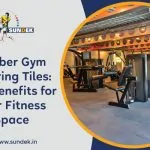Basketball is a fast-moving, high-demand sport that requires a surface that promotes both safety and play. Whether designing an indoor professional court or an outdoor recreational facility, selecting the right flooring is crucial. The material used for flooring has a direct impact on gameplay, player safety, and court durability. From hardwood floors that provide a traditional and smooth playing surface to durable outdoor options like rubber and vinyl, each material has its advantages. This guide will walk you through the various materials available, highlight key factors to consider when choosing the right flooring, and explain the long-term benefits of investing in high-quality basketball court flooring. Whether you prioritize durability, cost, or maintenance, finding the right flooring solution will enhance both performance and player experience.
Types of Basketball Court Flooring Materials

The choice of flooring material depends on various factors, including budget, location, and the level of play. Understanding the benefits and drawbacks of various materials helps in making an informed selection. Below, we look at the three most common types of basketball court flooring materials:
Wood Flooring
Pros and Cons
Wood flooring is the traditional choice for indoor basketball courts and is often seen in professional arenas. The main advantage of wooden floors is their smoothness and resilience, providing the ideal surface for high-intensity sports like basketball. It provides good shock absorption, which lowers the chance of injury. The natural aesthetic of hardwood, especially maple, gives a premium, professional look to any court. However, wooden floors can be expensive to install and maintain, and they may require refinishing over time due to wear and tear from constant use.
Popular Choices (e.g., Maple, Oak)
Maple: Known for its durability and smooth finish, maple is the most popular choice for basketball courts. It’s resistant to dents and scratches, making it ideal for high-traffic areas.
Oak: Slightly less expensive than maple, oak is also durable and offers a good balance between cost and performance.
Synthetic Flooring
Pros and Cons
Synthetic flooring is a lower-cost alternative to hardwoods. It’s available in various materials, including rubber, vinyl, and polyurethane, providing good durability, ease of maintenance, and shock absorption. Synthetic surfaces are often easier to install and maintain than wood, and they are less prone to damage from moisture, making them ideal for both indoor and outdoor courts. However, they may lack the authentic feel and aesthetic of hardwood, and certain types can be more slippery or provide less traction.
Popular Choices (e.g., Rubber, Vinyl)
Rubber Flooring: Durable and slip-resistant, rubber flooring is a great choice for both indoor and outdoor courts. It provides a high level of shock absorption and is easier to maintain than wood.
Vinyl Flooring: Often used in multi-purpose courts, vinyl is versatile and comes in various designs and colors. It’s easy to clean but may not offer as much shock absorption as rubber.
Concrete Flooring
Pros and Cons
Concrete is a typical choice for outdoor basketball courts since its cost and longevity. It can withstand harsh weather conditions and heavy use without significant wear. However, concrete surfaces can be hard, providing less shock absorption, which can lead to higher impact on players’ joints. Concrete also requires proper sealing and may be prone to cracking if not installed correctly.
Considerations for Outdoor Courts
For outdoor courts, concrete is the most common material used due to its cost-effectiveness and weather resistance. It’s important to use the right sealants to protect the surface from moisture and UV damage.
Factors to Consider When Choosing Basketball Court Flooring
Choosing the perfect basketball court flooring is almost simply selecting a material. Several key factors must be considered to ensure that the flooring provides the right performance and longevity:
Budget
Your budget is a primary factor when choosing basketball court flooring. Wood flooring offers premium performance but comes at a higher cost, while synthetic and concrete options provide more budget-friendly alternatives. Determine your budget and prioritize the most important features, such as durability and performance.
Location (Indoor or Outdoor)
The location of your court will significantly affect the type of flooring material you choose. Indoor courts generally benefit from wooden or synthetic flooring, while outdoor courts need a more durable material like concrete or rubber that can withstand the elements.
Maintenance Requirements
Consider the maintenance needs of the flooring. Wood requires periodic refinishing, while synthetic floors are easier to maintain. Concrete surfaces may require sealing to prevent damage from moisture and UV exposure. Choose a flooring material that fits your maintenance capacity.
Durability and Longevity
Select flooring that can stand up to high use over time. Wooden floors are durable but may need periodic maintenance. Synthetic floors and concrete surfaces, when properly maintained, can provide long-lasting performance, especially in high-traffic areas.
Performance Characteristics (e.g., Traction, Shock Absorption)
Look for flooring that provides the right balance of traction and shock absorption. Hardwood floors, for example, provide excellent shock absorption, reducing the risk of injuries. Synthetic and rubber floors offer excellent grip and less impact.
Customization and Design Options
A basketball court’s design and aesthetics can play a significant role in its appeal. Many flooring options offer customization to fit your style and brand.
Painted Designs and Logos
Customized logos and painted designs are a great way to give your court a professional look. You can create a vibrant, unique space with custom court markings and team logos, making the court visually engaging.
Inlaid Hardwood Patterns
For wooden floors, inlaid hardwood patterns can add a high-end, premium look to the court. Patterns can also aid in visual orientation and enhance the overall experience.
Color Options and Customization
Synthetic flooring options allow for a variety of colors and patterns. You can customize the court’s design to match the theme of your facility or team colors, providing a personalized touch that stands out.
Installation and Maintenance Tips
Proper installation and regular maintenance are key to ensuring that your basketball court flooring remains in optimal condition.
Hiring a Professional Installer: Professional installation ensures that the flooring is installed correctly, reducing the risk of problems such as uneven surfaces or inadequate adhesion. A professional installer can ensure that your court is level and all seams align properly.
Regular Maintenance and Cleaning Tips: To maintain the integrity of the flooring, it’s important to clean the surface regularly. For wood, this means periodic refinishing and polishing. For synthetic and rubber flooring, regular sweeping and mopping will suffice.
Repair and Replacement Considerations: If the flooring becomes damaged, it’s important to repair it promptly to avoid further deterioration. Replacement parts should be sourced from reliable suppliers to ensure compatibility and maintain performance standards.
Who is the Manufacturer of Basketball Court Flooring?
Sundek Sports Private Limited is a reputable basketball court flooring manufacturer in India, providing excellent flooring solutions for indoor as well as outdoor courts. They specialize in durable, customizable, and cost-effective options designed to meet the needs of various facilities. Sundek Sports ensures that its basketball court flooring not only delivers top-tier performance but also adds aesthetic appeal to the court. Our products are crafted for reliability and long-lasting use, making them an excellent choice for professional sports facilities, schools, and recreational areas. With a focus on quality and innovation, we continue to lead as a prominent basketball court flooring manufacturer, providing a range of solutions that guarantee optimal playability and safety. Whether you need durable indoor flooring or robust outdoor surfaces, Sundek Sports is the go-to choice for your basketball court flooring needs.
Conclusion
When choosing the best basketball court flooring for 2025, it’s important to consider the material type, maintenance requirements, and performance characteristics. Whether you choose wood, synthetic, or concrete, each option has its benefits. With the proper care and maintenance, your basketball court will provide an excellent playing surface for years to come.
Investing in high-quality basketball court flooring ensures a safe, durable, and visually appealing court that can handle the demands of any game. If you’re looking to upgrade your court or start from scratch, choose a reliable supplier like Sundek Sports Private Limited for your flooring needs. For further inquiries, call +91 93203 08938 or email info@sundek.in today.
FAQ
What are the most common materials used for basketball court flooring?
The most common materials are hardwood (usually maple), synthetic rubber, vinyl, and concrete. Each material has its own advantages depending on whether the court is indoor or outdoor.
Why is hardwood flooring popular for basketball courts?
Hardwood, particularly maple, is popular for basketball courts due to its durability, smooth surface, and excellent shock absorption. It also provides professional aesthetics and enhances gameplay with reduced risk of injury.
What is the difference between indoor and outdoor basketball court flooring?
Indoor courts usually use wood or synthetic flooring, while outdoor courts use concrete or rubber. Outdoor flooring must withstand weather, whereas indoor floors focus on performance and comfort.
How durable is synthetic rubber flooring for basketball courts?
Synthetic rubber flooring is extremely resilient as well as resistant to wear. It provides good traction, is easy to maintain, and is cost-effective, making it a popular choice for both indoor and outdoor basketball courts.
Is vinyl flooring a good option for basketball courts?
Vinyl flooring is affordable and easy to maintain. While it offers good durability and comfort, it is not as durable as hardwood or rubber and may wear out quicker with heavy usage.
How do I maintain my basketball court flooring?
Maintaining basketball court flooring involves regular cleaning, periodic refinishing for wood floors, and checking for wear and tear. For synthetic or rubber floors, sweeping and mopping are usually sufficient to keep them clean.
What are the advantages of using rubber flooring for basketball courts?
Rubber flooring provides excellent shock absorption, reduces noise, and offers durability, making it ideal for outdoor courts. It also requires minimal maintenance and can withstand harsh weather conditions effectively.
What is the cost of installing basketball court flooring?
The cost varies based on material and installation type. Wood flooring tends to be the most expensive, while synthetic and rubber options are more budget-friendly. Installation and maintenance costs should also be considered.
How long will my basketball court flooring last?
The material and usage determine how long basketball court flooring lasts. Hardwood floors can last 15-20 years with proper maintenance, while synthetic and rubber floors last around 10-15 years with regular upkeep.
Can I customize my basketball court flooring design?
Yes, many flooring options, especially synthetic and vinyl, offer customization in colors, logos, and court markings. Custom designs can enhance the visual appeal and match the branding or theme of your facility.






